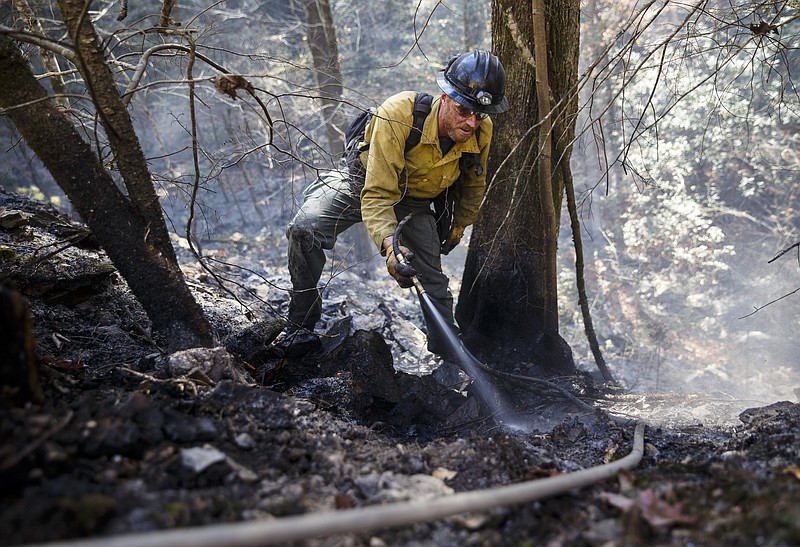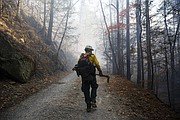About the Rough Ridge fire
The basicsGeorgia’s Rough Ridge fire, started by a lightning strike at about 3:15 p.m. Oct. 16, has consumed more than 28,000 acres of the Cohutta Wilderness Area of the Chattahoochee National Forest. It is about 13 miles west of Blue Ridge, which is in Fannin County. The incident command post now is in Chatsworth in Murray County.Just how big is it?For comparison, the Chickamauga Battlefield in Georgia (not the entire Chickamauga and Chattanooga National Military Park) encompasses 5,300 acres. In square miles, the fire covers an area more than half the size of Seattle.Current situationThe fire is 40 percent contained, and 243 personnel are fighting it. There are three crews, two helicopters, seven engines, four water tenders and two bulldozers assigned. The Conasauga Ranger District has brought in more law enforcement personnel to help with road closures and fire restrictions. An incident management team from Southern California took command of the firefighting effort Friday morning. The main fire is moving west toward the Conasauga River and chewing through unburned forest.What’s feeding it?Pine trees, hardwoods and shrubbery are burning. Hardwood leaf litter is the “primary fuel,” and leaves are complicating matters by falling on containment lines and catching fire again.Weather outlookLow humidity, little chance for significant precipitation and gusts of high winds are worsening the problem.When will it end?The fire has an estimated containment date of Nov. 30. If that containment holds, with mop-up efforts and, hopefully, some rain, the fire eventually will burn itself out.Source: inciweb.nwcg.gov, as of 3 p.m. Friday
CISCO, Ga. - Law enforcement agencies around the Southeast are cracking down on arsonists this fall, but a long-suppressed pyromaniac responsible for starting the nation's largest active wildfire won't be charged with a crime.
In fact, Mother Nature is receiving admiration from forestry experts for sparking flames they say are long overdue.
Firefighters from around the country are prepared to miss Thanksgiving with their families as they control the 28,000-acre wildfire in North Georgia's Cohutta Wilderness, which has contributed to the smoke that has blanketed the region.
But for the most part, these crews are now gently guiding and restraining the fire, allowing it to simmer, as they vigilantly wait for rains to end what started here more than a month ago.
"It's a unique fire for all these going on in the southern Appalachians because it's burning in a wilderness," said Mary Stuever, a district forester from New Mexico who is serving a two-week assignment in the Cohutta Wilderness.
"There is no such thing as good fire or bad fire, but if you were going to make that polarization, this is basically a good fire," Stuever said. "This is a story of fire having an opportunity to come back on the landscape, and we do anticipate there will be some really positive results ecologically."
The low-burning fire is expected to flush the system in a healthy way for plants and animals that need fire but haven't seen it in years because of population growth and modern firefighting.
Still, the fire's magnitude is staggering. Officials say it is the largest the area has seen in decades, and there is private property - homes included - dotting the fire's outskirts. Crews are working 16-hour shifts monitoring their containment lines to ensure flames don't hop fire breaks, reach new fuel sources and threaten structures.
Officials have identified the source of the fire: a tree among the millions in the Chattahoochee National Forest that was struck by lightning, igniting the blaze that was discovered on Oct. 16 in an area called Rough Ridge.
The blaze grew and grew and grew after it was initially allowed to burn. By Nov. 10, nearly 300 fire personnel from around the country had been summoned to be "fire cowboys," as Stuever put it.
"We're here to herd the fire," Stuever said. "It is a wildfire; it's not like we have control over it. Fire is a chaotic force, but we're doing the best we can with our resources and what we know to keep that fire staying in the national forest."
***
Ray Miller leaned down to look at a seemingly out-of-place piece of charred timber on a dirt road winding between a cliff and a leafy creek bed at the fire's northwest edge.
"See, this is what we're talking about," the safety officer from Pennsylvania's forestry division said. "A chunk like this rolls off the bank somewhere, it's still hot, and if it rolls down here across the road, it's back to the races."
Monitoring the fire line is a mixture of mundane and exciting, but one rolling piece of hot timber showed why keeping a close eye on the line is essential to a wildland firefighting operation.
Deep in the woods, a few miles east of an unincorporated Murray County town called Cisco and just a couple miles south of Polk County, Tenn., the fire jumped its break sometime early Friday morning, using dry leaves and trees to try and hop across the creek.
"We could lose the entire operation from a little spot like this," said Luis Saez, a crew boss for a team from Puerto Rico, who spotted the smoke on his way to the line that morning.
Saez spoke above the noise of his crew members' leaf blowers as they sought to clear the creek bed of any fuel sources for the fire.
He and his crew are scheduled to return home Wednesday. They arrived in Lexington, Ky., last month, spending two days on an Alabama fire and having their time on the mainland extended twice so they could assist with the Cohutta Wilderness fire.
The first half of the year is south Puerto Rico's busy fire season, he said. The second half of the year is when the crew is likely to be sent on five or six assignments on the mainland through an interagency partnership.
"We're counting the days down," he said. "We'll be home the day before Thanksgiving, God permitting. We'll get to be with our kids, our wives. We're counting down the days."
However, many of the 200-plus personnel working in the Cohutta Wilderness are part of a newly arrived incident response team that will spend Thanksgiving at hotels in Dalton, Ga., and out on the line with leaf blowers and hand tools, waiting for significant rain.
Seth Mitchell, 32, said his family is accustomed to him being gone from their California home. Mitchell, who was serving as the division leader Friday, is on a three-week assignment away from the Angeles National Forest where he is headquartered.
"I have a 10-year-old daughter and she just knows that Daddy is always gone on a fire," he said. "You definitely need a support group at home to do this job."
Mitchell said the firefighting crews might have turkey sandwiches for lunch on Thanksgiving. But it will depend on what's going on at the fire line.
"It's hard to know what will happen," he said.
Bob Maharrey, of Birmingham, Ala., called his wife "a fire widow" and his kids "fire orphans." He knows he'll have to miss Thanksgiving, and so do they, he said.
But, Maharrey said, this Cohutta Wilderness fire carries a certain level of luxury compared to some of the other fires in more isolated locations he has battled across the country in his career as a wildland firefighter.
"We're totally so thrilled that we got to sleep in hotels on this fire," he said. "We have tents, sleeping bags and all that, and we're always ready to sleep out, so it's a luxury to sleep in a hotel. The best part about Southern firefighting is getting to sleep in a hotel and eating in a restaurant."
Like most of the teams in the area working on the fire, Maharrey is staying in Dalton, driving to Chatsworth for morning briefings at the U.S. Forest Service's temporary headquarters, and then heading to the fire line until long after dark.
Maharrey said he has been a wildland firefighter for 20 years and has still never fought a fire in his home state of Alabama.
"You can literally work in Florida and Alaska in the same year," he said. "Guys get into it for different reasons. I was pretty ignorant when I got into it. I had no idea. I just knew that it would seem like fun to go out on a fire engine for a little bit. I didn't realize just how much country I was going to see."
Kyle Owen, of California, is in training to be a division supervisor. He said he got a wildland firefighting job straight out of high school, attracted to it because he would not have to sit behind a desk.
"I grew up in the mountains and like to run around and play outside," he said. "This came up and seemed like something that would be pretty fun. I've been doing it ever since."
They don't all have college degrees, but the firefighters assigned to the Cohutta Wilderness are specially trained and part of a regimented, hierarchical process that can ensure the nation's best firefighters are sent to its most urgent fires once local and state agencies are overwhelmed.
Their skills and vocabularies are robust when it comes to strategically containing flames.
"Everybody I talk to, they think you're just aiming a hose at the top of the trees," said Nate Huestis of Hiawatha, Kan. "They don't realize that what we're doing is setting a backfire so that the main fire doesn't have anything to eat. That's how you fight wildland fires."
***
If the Cohutta Wilderness fire were "crowning," the firefighting strategy might involve aiming hoses at the tops of trees.
And the expected ecological effects would be much different.
A crowning fire burns higher, from tree to tree, is more intense and can cause soil destruction, such as loss of nutrients and removal of debris needed to protect seedlings, according to the National Park Service.
While Stuever said it's possible the Cohutta Wilderness fire has "crowned out" in places, it has been classified as a surface fire from the start.
The same goes for most of the fires seen across the region during the current drought.
"A lot of it is just this low, creeping fire," University of Tennessee forestry professor Jennifer Franklin said. "I think there are some areas where it'll have some significant ecological effects, but that's not necessarily a bad thing."
Maharrey, Huestis and Devin Delaney took a few minutes to eat and rest Friday morning as they waited on a truck from Gilmer County Fire and Rescue. It was coming to replenish the water supply in their type-6 engine that Maharrey referred to as "the Swiss Army knife" of wildland fighting vehicles.
The three were preparing to wet down some of the smoldering hillside next to them but wanted to refill the 250-gallon tank in the truck bed before getting started.
Finally, Adam Payne from Gilmer County Fire and Rescue pulled up in a hulking red truck nearly as wide as the dirt road.
Payne hopped out and got the water exchange started. As a local, he's heard the complaints about the smoke and heard the murmurs of concern about the fire. He also hasn't slept at home in nearly a week.
"It's a balancing act, and people don't get it," he said. "Don't get me wrong, I'm ready for some rain. But this had to happen. It needed to happen.
"It's what Mother Nature was designed to do."
Contact staff writer David Cobb at dcobb@timesfreepress.com or 423-757-6249.

